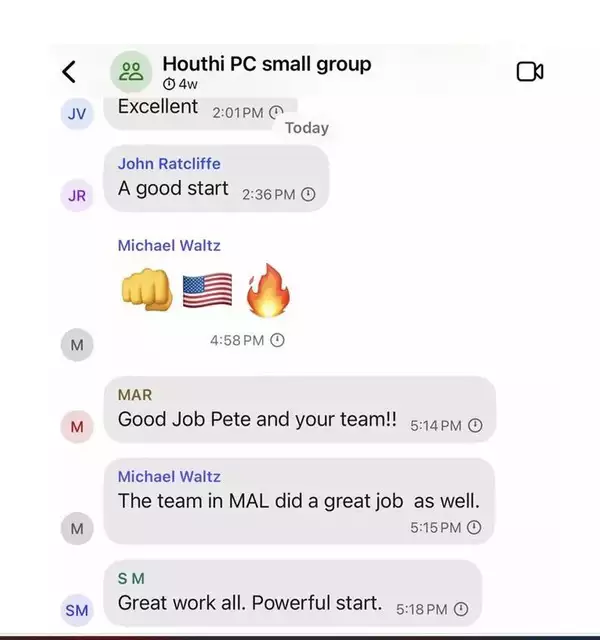Once upon a time, journalists waited months or years for classified leaks. In 2025, all it took was a Signal invite. That’s how Atlantic editor Jeffrey Goldberg found himself inside the highest-level US national security conversation about bombing Houthi targets in Yemen. The chat, blandly titled “Houthi PC small group,” was anything but ordinary. It revealed, in real time, how the Trump administration planned and launched airstrikes halfway around the world—from a smartphone.
The leak is unprecedented not only for what it shows, but how it happened. And beyond the operational exposure, it offers a raw, unscripted look into how American power now gets exercised: through group chats, emojis, unfiltered ego, and impulsive decision-making.
How It Started: An Accidental Add

On March 11, 2025, Goldberg received a Signal message from a user labeled “Michael Waltz,” who was indeed the National Security Adviser. The invite led to a group chat called “Houthi PC small group,” which quickly filled with high-ranking officials: Defense Secretary Pete Hegseth, CIA Director John Ratcliffe, DNI Tulsi Gabbard, Vice President JD Vance, and others. One by one, they chimed in, naming deputies and staff contacts. And no one seemed to notice Goldberg was in the room.
Within hours, the chat moved from coordination to operational. Waltz began distributing high-side taskings, and by the next morning, discussions turned to sequencing strikes and managing the political optics. Goldberg remained a silent observer. And soon, a very loud war would begin.
Planning by Text: Strategy, Doubts, and Messaging
Friday, March 14 began with updates from Waltz, citing Presidential direction. The strike had been greenlit, and the administration needed to coordinate notifications, costs, and public narrative. But even inside this hawkish circle, there was dissent.
Vice President JD Vance raised early objections. The Houthi threat to US trade, he noted, was minimal: only 3%. European exposure was much higher. Why rush in, he asked, without building public understanding? What about oil prices? Was the President aware of how this action conflicted with his broader messaging?
What was most striking was not just Vance’s policy caution—it was his quiet deviation from Trump. In public, Vance has been the picture of loyalty, often echoing the president’s lines without hesitation. But in the chat, he questioned whether Trump himself grasped the contradictions. It was a rare window into a vice president with more on his mind than the party line.
Others responded swiftly. Joe Kent from DNI said the timeline wasn’t urgent. Ratcliffe at CIA noted that more time might even help refine targets. Hegseth, however, wasn’t interested in waiting.
“This is not about the Houthis,” he said. “It’s about restoring freedom of navigation. Reestablishing deterrence. Messaging is tough either way.”
Waltz backed him, citing trade data and Europe’s naval weakness. Whether now or later, the US would need to act. And they were already working on how to send Europe the bill. In fact, if the chat revealed one recurring theme besides military coordination, it was barely concealed disdain for America’s allies. JD Vance lamented having to “bail Europe out again.” Hegseth called their navies “PATHETIC.” Stephen Miller insisted that economic gain must be extracted if the US does the heavy lifting. This was not a coalition. It was a rescue mission with an invoice.
Execution Day: The Chat Becomes a War Room

On Saturday, March 15, the chat turned fully operational. At 11:44 a.m., Hegseth dropped the message: “WE ARE A GO.” It included detailed timing: F-18s launch at 12:15. Drones hit at 2:15. Tomahawks fly at 3:36. It was a digital flight plan for a real-world airstrike, texted in plain language.
Goldberg, stunned, waited. At 1:55 p.m., social media lit up: explosions reported in Sanaa.
Back in the chat, National Security Adviser Waltz confirmed: the first building had collapsed. The target—a top Houthi missile commander—had been seen entering. JD Vance asked for clarity. Waltz replied: “Typing too fast. He walked into his girlfriend’s building. It’s now collapsed.”
Vance replied: “Excellent.”
Emoji Diplomacy: Aftermath and Applause

Once the dust settled, the tone shifted sharply from strategic to celebratory. Ratcliffe called it a “good start.” Waltz responded with a fist, flag, and fire emoji. MAR, presumably Marco Rubio, cheered on Pete’s team. Susie Wiles, the White House chief of staff, offered blessings. Stephen Miller returned to policy mode—insisting that Egypt and Europe must now be told what is expected in return.
The most revealing part of the aftermath wasn’t what was said, but what wasn’t. There was no debate about collateral damage. No mention of civilian deaths. No introspection about the possibility of blowback or diplomatic consequences. Just a sequence of congratulations, emoji-driven affirmations, and logistical follow-ups. According to the Yemeni health ministry, at least 53 people were killed. That didn’t surface in the thread.
Security Fallout: The Leak That Wasn’t Supposed to Be
It took Goldberg days to fully believe what he had witnessed. He left the chat, triggering a notification. Still, no one messaged him. When he went public, the administration downplayed everything: “No classified info was shared,” insisted Defense and Intelligence chiefs. Trump called it a mistake, and one to “learn from.”
But experts disagreed. National defense information was clearly transmitted on an unsecure channel. Even without classification stamps, the timing, target, and weapon sequencing qualified as sensitive. The fact that it reached a journalist—before the first bomb dropped—was more than a breach. It was a near-catastrophe.
The Legal and Political Storm
Several legal analysts now argue the Signal chat violated provisions of the Espionage Act and federal records laws. Signal is not an approved platform for government communications, let alone war planning. Officials are supposed to use SCIFs and secure systems. Waltz even set some messages to disappear—which may count as illegal deletion of federal records.
Beyond the legal implications, the leak cuts into Trump’s central campaign promise: strength and competence. The operation may have succeeded militarily, but the surrounding chaos suggests amateur execution. Even the messaging—so central to this operation—was derailed by the leak itself. Vance may have said it best, days before the strike: “There is a real risk that the public doesn’t understand why this is necessary.”
They do now. But maybe not in the way the administration hoped.
The Houthi strike will be remembered for its precision. But it may be remembered more for its presentation. A war launched from Signal. A top target killed in his girlfriend’s apartment. National security shaped by emojis, political grievances, and accidental transparency.
For all the talk of restoring deterrence, this episode may end up eroding a different kind of credibility: the idea that American power is guided by discipline, caution, and command.
Instead, it looked like a group chat. Because it was.




